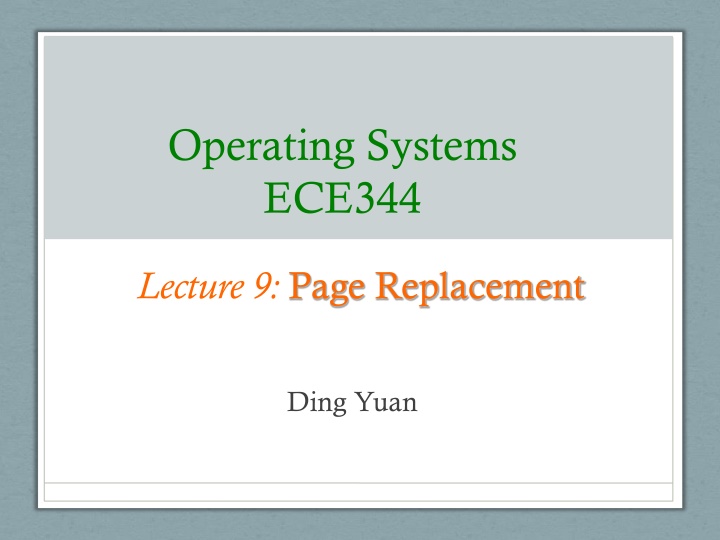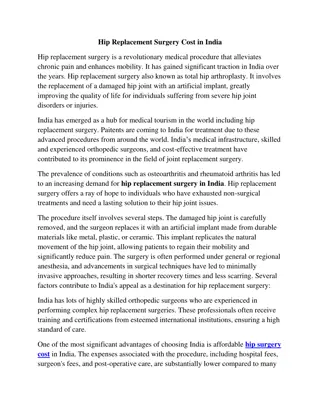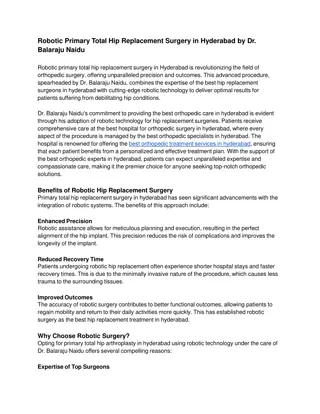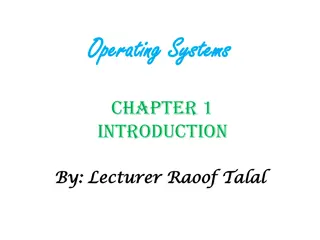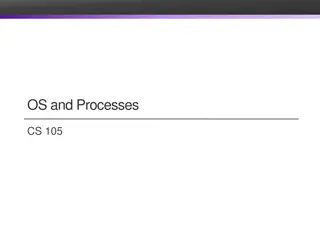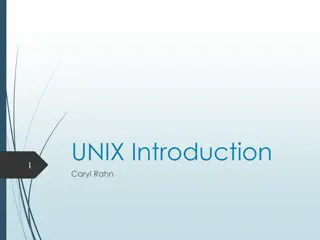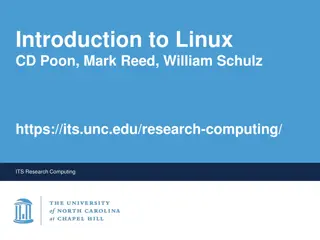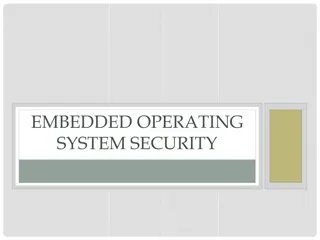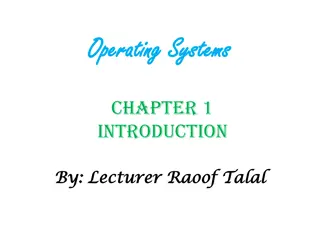Page Replacement in Operating Systems
Page replacement is a critical concept in operating systems, where memory management plays a vital role. In this process, pages are brought into and out of the main memory based on demand, leading to scenarios like page faults and eviction. Various strategies such as FIFO, LRU, and NRU are employed to decide which pages to replace, ensuring optimal memory usage and performance.
Download Presentation

Please find below an Image/Link to download the presentation.
The content on the website is provided AS IS for your information and personal use only. It may not be sold, licensed, or shared on other websites without obtaining consent from the author.If you encounter any issues during the download, it is possible that the publisher has removed the file from their server.
You are allowed to download the files provided on this website for personal or commercial use, subject to the condition that they are used lawfully. All files are the property of their respective owners.
The content on the website is provided AS IS for your information and personal use only. It may not be sold, licensed, or shared on other websites without obtaining consent from the author.
E N D
Presentation Transcript
Operating Systems ECE344 Lecture 9: Page Replacement Ding Yuan
Review For a memory access instruction Does it use a virtual address or physical address? What can happen? Best case What if you are unlucky? Demand paging What is it? Page fault What is it? Why does it happen? Who handles it? How costly is it? 2 ECE344: Page Replacement Ding Yuan
Demand Paging Algorithm Algorithm NEVER brings a page into main memory until it is needed 1. Page fault 2. Check if a valid virtual memory addr. Kill proc. if not. 3. If valid address, check if it s cached in memory already (perhaps by other processes). If so, skip to 7. How can this be possible? 4. Find a free page frame. If no free page available, choose one to evict (which one? focus of this lecture) If the victim page is dirty, write it out to disk first 5. Suspend user process, map address into disk block and fetch disk block into page frame 6. When disk read finished, add vm mapping for page frame 7. If necessary, restart process. 3 ECE344: Page Replacement Ding Yuan
Demand Paging (detail) Some Pages are evicted to disk when memory is full Pages loaded from disk when referenced again References to evicted pages cause a TLB miss PTE was invalid, causes fault OS allocates a page frame, reads page from disk When I/O completes, the OS fills in PTE, marks it valid, and restarts faulting process Dirty vs. clean pages Actually, only dirty pages (modified) need to be written to disk Clean pages do not but you need to know where on disk to read them from again 4 ECE344: Page Replacement Ding Yuan
Issue: Eviction Hopefully, kick out a less-useful page Goal: kick out the page that s least useful Problem: how do you determine utility? Kick out pages that aren t likely to be used again Heuristic: temporal locality exists 5 ECE344: Page Replacement Ding Yuan
Page Replacement Strategies The Principle of Optimality Replace the page that will not be used again the farthest time in the future Random replacement Choose a page randomly FIFO First In First Out Replace the page that has been in memory the longest LRU Least Recently Used Replace the page that has not been used for the longest time NRU Not Recently Used An approximation to LRU 6 ECE344: Page Replacement Ding Yuan
Beladys Algorithm Known as the optimal page replacement algorithm because it has the lowest fault rate for any page reference sequence Idea: Replace the page that will not be used for the longest time in the future Problem: Have to predict the future! Why is Belady s useful then? Use it as a yardstick Compare implementations of page replacement algorithms with the optimal to gauge room for improvement If optimal is not much better, then algorithm is pretty good If optimal is much better, then algorithm could use some work Random replacement is often the lower bound 7 ECE344: Page Replacement Ding Yuan
Optimal Example 12 references, 7 faults Miss rate: 7/12 Hit rate: 5/12 8 ECE344: Page Replacement Ding Yuan
First-In First-Out (FIFO) FIFO is an obvious algorithm and simple to implement Maintain a list of pages in order in which they were paged in On replacement, evict the one brought in longest time ago Why might this be good? Maybe the one brought in the longest ago is not being used Why might this be bad? Then again, maybe it s not We don t have any info to say one way or the other FIFO suffers from Belady s Anomaly The fault rate might actually increase when the algorithm is given more memory (very bad) 9 ECE344: Page Replacement Ding Yuan
FIFO 12 references, 9 faults Miss rate: 9/12 Hit rate: 3/12 10 ECE344: Page Replacement Ding Yuan
Intuitive Paging Behavior with Increasing Number of Page Frames 11 ECE344: Page Replacement Ding Yuan
Beladys Anomaly (for FIFO) 12 references, 10 faults 1 2 3 4 5 6 7 8 9 10 11 12 12 ECE344: Page Replacement Ding Yuan
Least Recently Used (LRU) LRU uses reference information to make a more informed replacement decision Idea: We can t predict the future, but we can make a guess based upon past experience On replacement, evict the page that has not been used for the longest time in the past (Belady s: future) When does LRU do well? When does LRU do poorly? Implementation To be perfect, need to time stamp every reference (or maintain a stack) much too costly So we need to approximate it 13 ECE344: Page Replacement Ding Yuan
LRU 12 references, 10 faults Evict A (Least Recent) Evict B (Least Recent) No Belady s anomaly why? 14 ECE344: Page Replacement Ding Yuan
Approximating LRU: NRU NRU: Evict a page that is NOT recently used; LRU: evict a page that is LEAST recently used NRU Implementation: simpler than LRU uses reference bit a counter is kept per page At regular intervals, for every page do: if ref bit = 0, increment counter if ref bit = 1, zero the counter zero the reference bit The counter will contain the number of intervals since the last reference to the page The page with the largest counter is the least recently used 15 ECE344: Page Replacement Ding Yuan
LRU Clock Used by Unix Replace page that is old enough Arrange all of physical page frames in a big circle (clock) A clock hand is used to select a good LRU candidate Sweep through the pages in circular order like a clock If the ref bit is off, it hasn t been used recently What is the minimum age if ref bit is off? If the ref bit is on, turn it off and go to next page Arm moves quickly when pages are needed Low overhead when plenty of memory 16 ECE344: Page Replacement Ding Yuan
LRU Clock 17 ECE344: Page Replacement Ding Yuan
LRU Clock 18 ECE344: Page Replacement Ding Yuan
LRU Clock 19 ECE344: Page Replacement Ding Yuan
LRU Clock Victim page 20 ECE344: Page Replacement Ding Yuan
Switching Gear So far, all we have talked about is memory management for a single process What about multiple processes? If we just use demand paging for each process, why do we care? 21 ECE344: Page Replacement Ding Yuan
Thrashing and CPU utilization As the page fault rate goes up, processes get suspended on page queues for the disk The system may try to optimize performance by starting new jobs But is it always good? Starting new jobs will reduce the number of page frames available to each process, increasing the page fault requests System throughput plunges 22 ECE344: Page Replacement Ding Yuan
Fixed vs. Variable Space In a multiprogramming system, we need a way to allocate memory to competing processes Problem: How to determine how much memory to give to each process? Fixed space algorithms Each process is given a limit of pages it can use When it reaches the limit, it replaces from its own pages Local replacement Some processes may do well while others suffer Variable space algorithms Process set of pages grows and shrinks dynamically Global replacement One process can ruin it for the rest 23 ECE344: Page Replacement Ding Yuan
Working Set The working set model assumes locality The principle of locality states that a program clusters its access to data and text temporarily As the number of page frames increases above some threshold, the page fault rate will drop dramatically 24 ECE344: Page Replacement Ding Yuan
Working Set Model A working set of a process is used to model the dynamic locality of its memory usage Defined by Peter Denning in 60s Definition WS(t,w) = {pages P such that P was referenced in the time interval (t, t-w)} t time, w working set window (measured in page refs) A page is in the working set (WS) only if it was referenced in the last w references 25 ECE344: Page Replacement Ding Yuan
Working Set Size vs. Page Faults 26 ECE344: Page Replacement Ding Yuan
Working Set Size The working set size is the number of pages in the working set The number of pages referenced in the interval (t, t-w) The working set size changes with program locality During periods of poor locality, you reference more pages Within that period of time, the working set size is larger Intuitively, want the working set to be the set of pages a process needs in memory to prevent heavy faulting Each process has a parameter w that determines a working set with few faults Denning: Don t run a process unless working set is in memory 27 ECE344: Page Replacement Ding Yuan
Working Set Problems Problems How do we determine w? How do we know when the working set changes? Too hard to answer So, working set is not used in practice as a page replacement algorithm However, it is still used as an abstraction The intuition is still valid When people ask, How much memory does Firefox need? , they are in effect asking for the size of Firefox s working set 28 ECE344: Page Replacement Ding Yuan
Page Fault Frequency (PFF) Page Fault Frequency (PFF) is a variable space algorithm that uses a more ad-hoc approach Monitor the fault rate for each process If the fault rate is above a high threshold, give it more memory So that it faults less But not always (FIFO, Belady s Anomaly) If the fault rate is below a low threshold, take away memory Should fault more But not always Hard to use PFF to distinguish between changes in locality and changes in size of working set 29 ECE344: Page Replacement Ding Yuan
Summary Page replacement algorithms Belady s optimal replacement (minimum # of faults) FIFO replace page loaded furthest in past LRU replace page referenced furthest in past Approximate using PTE reference bit LRU Clock replace page that is old enough Working Set keep the set of pages in memory that has minimal fault rate (the working set ) Page Fault Frequency grow/shrink page set as a function of fault rate Multiprogramming Should a process replace its own page, or that of another? 30 ECE344: Page Replacement Ding Yuan
